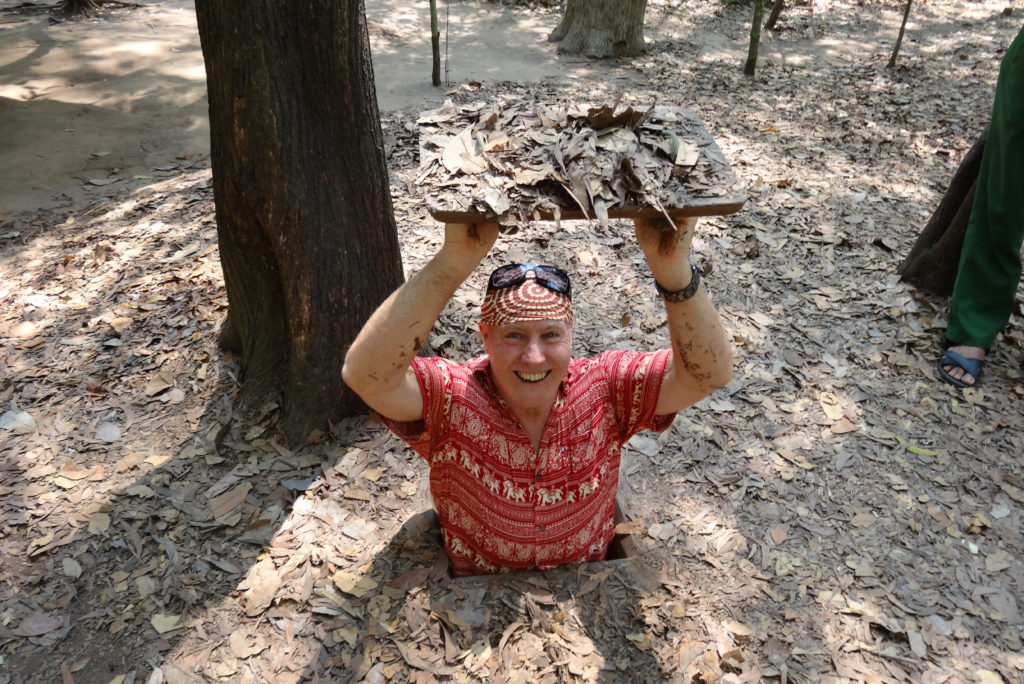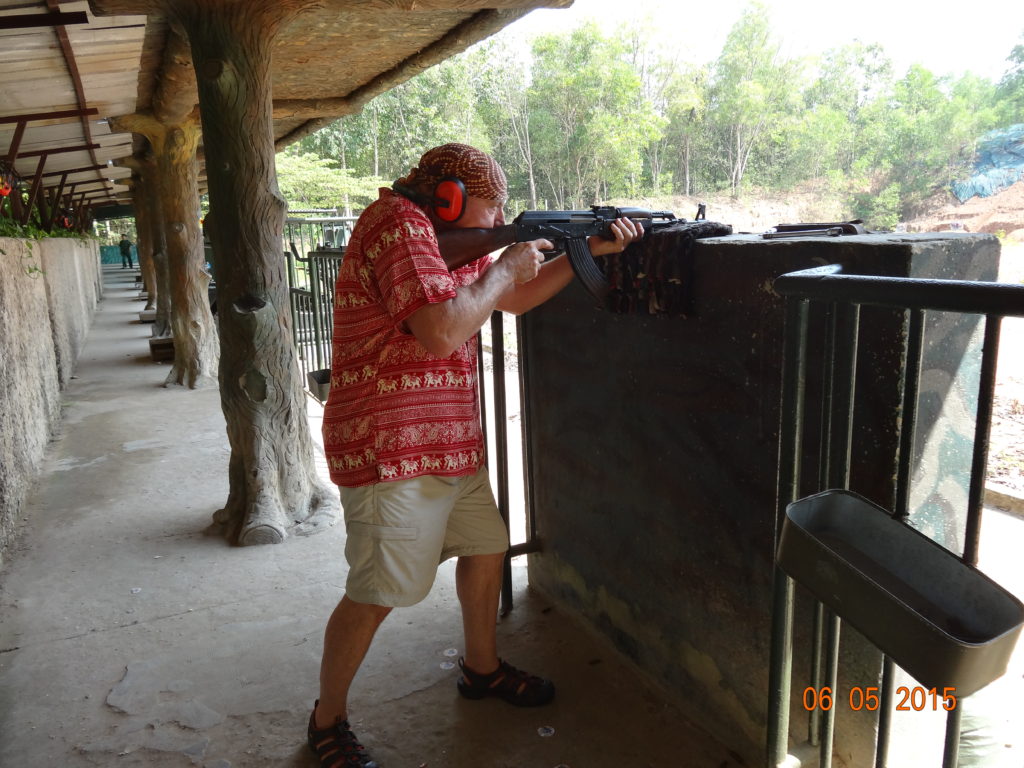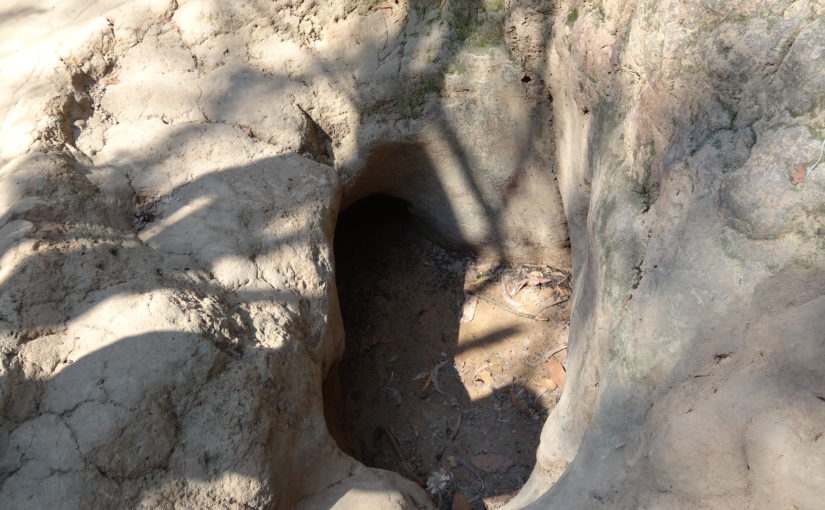Travel period May 2015
Crawling Through the Cu Chi Tunnels
One of the highlights of our time in Vietnam was an excursion out to the Cu Chi Tunnels. The tunnel in fact was the main reason for us to visit the city. We booked a private half-day tour through the travel agent near our hotel, with transportation, English-speaking tour guide, lunch and entrance fee included.

The American War
To give you a little overview, between 1954 and 1975 there was a controversial war between communist Northern Vietnam (and ally, Viet Cong, in the South) and Southern Vietnam (and ally, The United States).
The Viet Cong were a south Vietnamese communist front, also known as the National Liberation Front, and fought a guerrilla war against their southern brothers.
The People’s Army of Vietnam (also known as the North Vietnamese Army, NVA) fought a more conventional war, known to westerners as the Vietnam War. This second Indochina War, was also known to its victors as “The American War” or “War Against the Americans to Save the Nation”.

It was crippling for the country on many levels, not least the Agent Orange chemicals that were sprayed across swathes of jungle, to ensure nothing would ever grow there again, polluting the water and soil. We also know the devastating effects that it had on the people of Vietnam (and also the allied forces) for generations afterwards.
While we knew this conflict had deeper meaning, we really didn’t understand the true human cost until we got there ourselves. Those facts don’t hit you until you do a tour like the Cu Chi tunnels. It doesn’t hit you until you find yourself on your hands and knees with low oxygen, dripping sweat and hyperventilating as you crawl through these tunnels. You then realize that regardless of which side they were fighting on, HUMANS were living/hiding in these tunnels and holes fighting a political war.

About Cu Chi Tunnel
Located some 60 kilometers to the Northwest of Ho Chi Minh City, the tunnels served as the headquarters of the Viet Cong during Vietnam War. The Cu Chi tunnel network is an extensive labyrinth of underground tunnels stretching all the way to the Cambodian border. They were built over a period of some 25 years and initial construction began in 1948 by the Viet Minh, during the war against the French.

During the American War, the tunnels were extended over an area of approximately 250 km, and assumed huge strategic importance to the Viet Cong fighting troops. They played an immense role in helping the Vietnamese troops win against the American insurgents.
Not only was it home for thousands of Viet Cong guerrillas, but it was also a complicated structure consisting of numerous trenches, bunkers, booby traps, bomb shelters and an amazing air ventilation system. Soldiers worked, slept, cooked, ate, and even went to school in these tunnels as conflict raged above. Regardless of what side of the political fence you sit, the way this war was fought by the Viet Cong from tunnels, with incredibly effective improvisations, such as rubber tires and bomb fragments, is impressive.
Nowadays, there are only two sets of the Cu Chi tunnels open to the public. These are the Ben Dinh and Ben Duoc sections. Ben Dinh was the base for the Cu Chi District Party Committee, while Ben Duoc (the bigger scale network) was the base of the Party Committee, also serving as the Headquarters of Saigon-Cho Lon-Gia Dinh zone and military zone.
The Tour
The bus picked us from our hotel at 9am. Our first stop was at a handicraft centre, supported by Vietnam government, and hiring handicapped workers to produce high quality handicrafts. We bought a lovely lacquered picture of a women walking in traditional Vietnamese dress, that was made using egg shells.
The techniques the artists and craftspeople used to turn crushed duck eggs and sea shells into lacquered art works were fascinating to watch, and it was another reminder of the raised incidence of disability in Vietnam, still, after Agent Orange. We stopped there for 30 minutes, listened to the explanation and demonstration on how the handicraft was made.

Our introduction to the tunnels involved watching an ancient video about the American War (the Vietnam War to the western world). Our tour guide was humorous, informative, and multitasking. She guided us through the tunnels site, and explained the history of the tunnels to us all, by herself.

We were brought to the field after the video session, to walk on the most bombed, gassed, and defoliated land on earth. We walked along some well-worn tracks with massive bomb craters to the sides. Just seeing the craters really brought home to us the amount of destruction those impacts must have caused, not just here, but also on the cities and villages.

Booby traps were used mainly to cause serious injury rather than killing the US soldiers. The reason was, if you killed one, only one was down. If you seriously wounded one, it took another two to take care of the disabled one.
The first tunnel entrance shown to us was narrow. The park staff demonstrated their skill of going into the tunnel. Along the way, there was a tiny sniper hole, but it was pretty interesting to experience the hole where soldiers waited for days and days underground.


Venturing further along these jungle paths bought us to an abandoned tank, a stark reminder of the serious business of war. During our walk, there were more inventive architecture that we were shown, such as vents from the underground kitchen that were disguised to look like rocks.
All the while we are taking in these sights, we could hear a peppering of gun shots from the shooting range which all added to the authentic ‘jungle under attack’ feeling.

After twenty minutes wandering in the forest, we were led to the shooting range, that, was located next to the resting area. They have a wide selection of guns at the range and we opted for the AK-47. This is a gun that is pretty hard to shoot legally anywhere else in the world. The bullets for the AK-47 are really expensive since they don’t legally manufacture them anymore.
They have a supervisor loading the guns for you and they make sure you get some headgear to protect your ears, since it is super loud. The guns are all mounted for safety reasons, but they give you a little wriggle room to aim.

We shot the AK-47 firing off a few rounds, the thing sounded like thunder and I can certainly say it was an exhilarating experience! The prices for the guns are pretty cheap, but the bullets are quite expensive. Each bullet is around $1-2 and you had to fire a minimum of 10, this isn’t cheap but I had never shot an AK-47 before, so I couldn’t pass up on the opportunity.

After the gun range, we headed for a walk through the actual Cu Chi tunnels. We went through the full distance, not very hard for us. There were several exits at certain distances, so we could get out of the tunnel whenever we felt uncomfortable. At the end of our tour, we were treated to a snack of tapioca root and pandan tea. This basic food staple formed a large part of the Viet Cong’s diet during the war.
The tour finished after this and we headed back to the city. It was a really great half day trip and totally worth it. We not only heard captivating stories about Vietnam’s history, but also experienced what life was like for soldiers during the war, as they lived their daily lives underground avoiding conflict that went on above. We also gained insight into the persistence and resourcefulness of the Vietnamese people, as we crawled on all fours through these tiny underground tunnels, and explored various rooms that served different purposes to those living inside.
FACT FILE
- A trip to the Cu Chi Tunnels is the perfect way of getting a new perspective on the Vietnam War, and experience what life was like for soldiers during the war.
- We booked our half day trip to the Cu Chi Tunnels through one of the local travel agents not far from our hotel – there were many local travel agents located on District 1. Be sure to shop around as price is very competitive (bargain is necessary).
- The tour costs anywhere between $30-50/person, with transportation, English-speaking tour guide, lunch and entrance fee included.
- We opted for a private tour – this gave us the flexibility of customizing the tour according to our taste. Moreover, this ensured we did not feel rushed at any time.
Note: The information provided in this post was correct at time of publishing but may change. For final clarification please check with the relevant service.
Also Read

